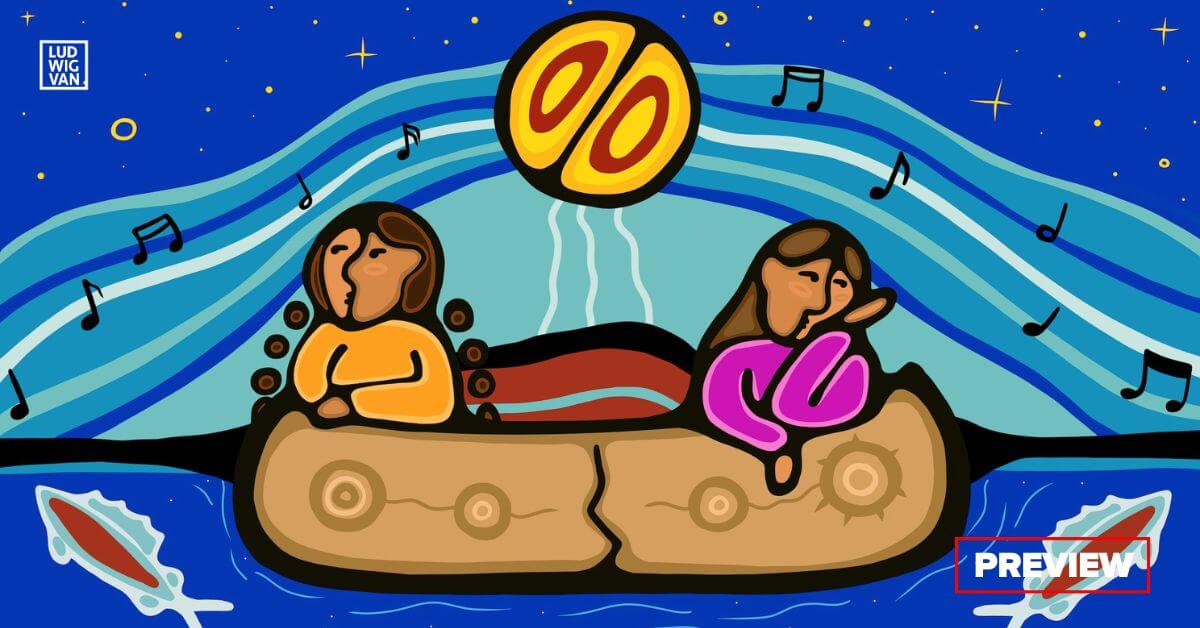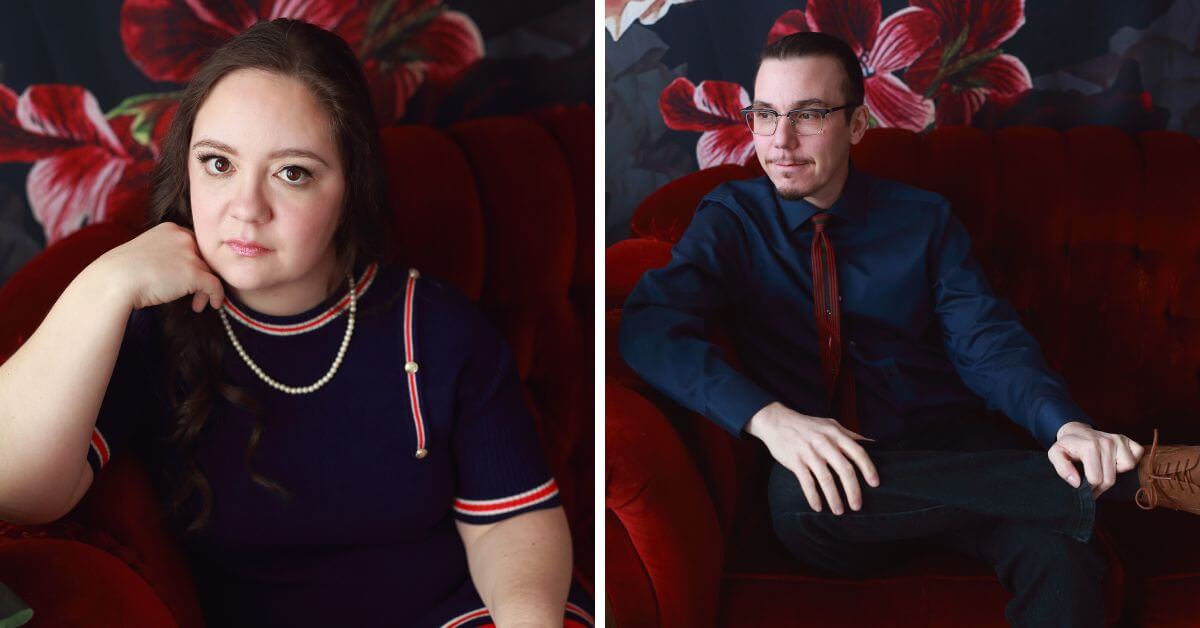
Toronto Consort have built an international reputation based on their mastery of period Western instruments and music. This fall, they’re launching their season with Canoe, a premiere two-act opera that blends old and new.
Presented as a production with Unsettled Scores in partnership with Toronto Consort, Native Earth Performing Arts and Theatre Passe Muraille, Canoe uses the power of Indigenous storytelling in operatic form.
The piece tells the story of two sisters and an ancestral tree, showcasing four Indigenous singers, and an ensemble of period instruments that includes recorder, violin, cello, lute and harpsichord.
We contacted Dr. Spy Dénommé-Welch (story, libretto and co-composer) and Catherine Magowan (co-composer), to delve into some of the details of the upcoming concert.
Dr. Spy Dénommé-Welch (Algonquin-Anishnaabe) is an interdisciplinary artist, scholar and educator, currently Associate Professor and Canada Research Chair — Critical Policy, Equity and Leadership Studies at the Faculty of Education, Western University.
He also serves as Artistic Director, Composer and Librettist or Unsettled Scores, a company dedicated to producing works that tackle difficult histories and their repercussions in contemporary society. He wrote and co-composed the Dora Mavor Moore-nominated opera Giiwedin, among many other stage and performance credits.
Bassoonist, composer, conductor, and arts administrator Catherine Magowan is a first-generation Canadian of Jewish-Hungarian ancestry. She is also a frequent collaborator of Spy Dénommé-Welch, with several co-compositions to their credit leading up to Canoe, including Giiwedin. She is Managing Director of Unsettled Scores.

Q&A With Spy Dénommé-Welch & Catherine Magowan
Q: How did this project — combining Indigenous vocalists and period Western instruments — come together?
A: We have worked with historical musicians for over a decade, prior to our first opera Giiwedin in 2010. The development of this music, and these artistic relationships, have been the continuation of a long process, and this project is the culmination of those collaborations and working relationships, which ultimately brought our producing partners together.
Q: In what (others) ways does the project diverge from the conventions of Eurocentric opera?
A: We have been working to shift and transform the traditional classical artistic hierarchy as much as we can towards a more process driven approach. We have four directors working in collaboration (Drs Spy Dénommé-Welch and Moynan King for stage, Catherine Magowan and Dr. Ben Stein for the music) who bridge multiple disciplines, and together we have worked towards establishing an environment that allows for open and frank conversations, the exchange of ideas, and experimentation.
We have also been working closely with a choreographer (Montana Summers) since the beginning of the rehearsal process to explore movement, embodiment and abstraction.
Our goal is to provide space for the performers to discover their characters’ personalities and movement vocabulary, and how these elements can support and work with the sonic and dramatic subtext of the work.
Q: In creating this innovative musical form, what do you hope to leave with your listeners/audience?
A: A realization that there is always room for innovation and exploration, and even playful inventiveness to encourage spaces for healing despite our difficult histories and topics (such as Canada’s Indian Residential School legacy and Indigenous genocide).
Music, storytelling and performance really aid in this process of doing healing work, and we are keen to show a pathway forward through art and music that weaves the spectrum of human emotion in ways that are imaginative and evocative.
Q: The story is about “two sisters, their ancestral tree, and an old but familiar visitor from the past…” — can you tell us anything more about the details of the story?
A: The story and plot tells the story of four characters, both individually and as an ensemble. While the characters’ individual trajectories and transformations intersect and weave throughout the opera as a whole, their storylines are also deeply interconnected.
The siblings, Gladys (Nicole Joy-Fraser) and Constance (Kristine Dandavino), are tied to the human world, whereas Debaajimod (Michelle Lafferty) and Tree Spirit (Conlin Delbaere-Sawchuk) move between planes to bridge the seen and unseen worlds.
Shortly into Act Two, these worlds collide and present the siblings with a new reality to navigate, while Tree Spirit (with Debaajimod’s guidance) comes to terms with a new identity and purpose that they could have never imagined.
Q: How does the music illustrate the story? (i.e. how do you connect the two aspects?)
A: The music of “Canoe” covers a variety of genres, experiments with style, shape and colour, and uses historical instruments in unusual ways. The textures we experiment with sonically are there to support the vocals and storytelling more broadly; there might be playful or serious moments in the piece that are underscored by a bluesy motif or choral structure that lifts and illustrates pivotal structures in the piece.
Further, these idioms may then be shifted and used at different points in ways that would almost seem contradictory or unexpected but provides deeper context to the story and help to accelerate the action. We also employ leitmotif in order to give the audience musical anchors that draw connections between characters, situations, and the complex emotions that emerge.
Q: Are there any other details you’d like us to include to introduce our readers to the work and the ideas/people behind it?
A: We hope this production can be viewed as an example of artistic interdisciplinarity, while developing new models and approaches for collaborations between diverse companies.
About The Artwork
A statement from artist Mishiikenh Kwe (Magnetawan First Nation), about the piece they created for the music:
“The piece was commissioned specifically for Canoe. It is inspired by Anishinaabe stories about floods and includes some elements shared with me about the production,” they said.
“The symbols on the canoe represent night and day and are disconnected to show that there’s a difference and possibly a conflict between the sisters, the stars representing various creation stories and the idea that we come from the stars.”
The Details
Performances of Canoe will take place September 15 & 16, with previews on September 12 & 13 at Trinity-St. Paul’s Centre in Toronto. Tickets and more information [HERE].
#LUDWIGVAN
Get the daily arts news straight to your inbox.
Sign up for the Ludwig van Daily — classical music and opera in five minutes or less HERE.
- PREVIEW | SUMMER OPERA LYRIC THEATRE Presents Handel’s Xerxes, Mozart’s Idomeneo & Puccini’a La Boheme July 26 To August 4 - July 26, 2024
- PREVIEW | YENSA Festival V.2 Offers Black Flames Performances & Other Ways To Celebrate Black Women In Dance - July 25, 2024
- PREVIEW | Canadian Talent Conspicuous In The Met: Live In HD 2024-25 Season - July 25, 2024



